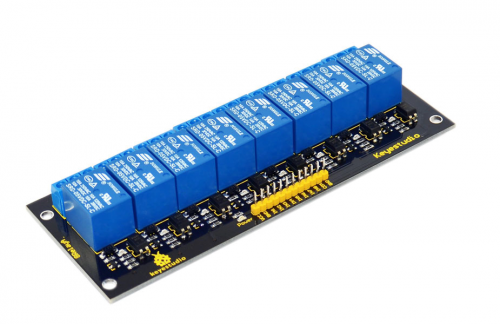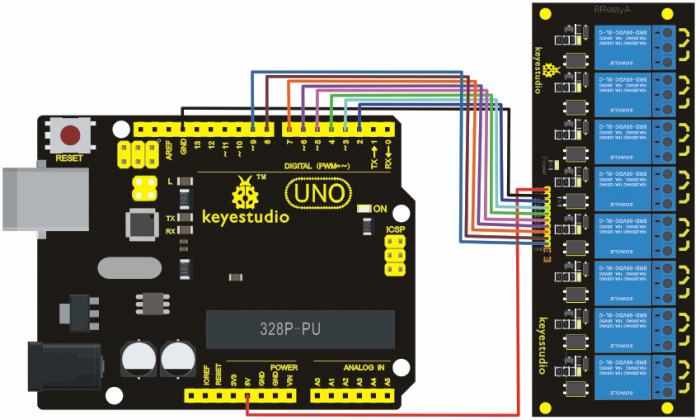Ks0059 keyestudio 8-channel 5V Relay Module: Difference between revisions
Jump to navigation
Jump to search
Keyestudio (talk | contribs) |
Keyestudio (talk | contribs) |
||
| (4 intermediate revisions by the same user not shown) | |||
| Line 1: | Line 1: | ||
== | |||
<br> | |||
==keyestudio 8-channel 5V Relay Module== | |||
<br>[[File:ks0059-1.png|500px|frameless|thumb]]<br> | <br>[[File:ks0059-1.png|500px|frameless|thumb]]<br> | ||
<br> | |||
==Introduction== | ==Introduction== | ||
Arduino Relay Shield employs high quality relay with eight channels input and eight channels output. It can be connected to 250V/10A AC element or 24V/10A DC element to the maximum, therefore, it can be used to control lights, motors | Arduino Relay Shield employs high quality relay with eight channels input and eight channels output. It can be connected to 250V/10A AC element or 24V/10A DC element to the maximum, therefore, it can be used to control lights, motors,etc.<br> | ||
The modularized design makes it easy to connect to Arduino expansion board. The output state of the relay is shown by a luminous diode for the convenience of actual application.<br> | The modularized design makes it easy to connect to Arduino expansion board. The output state of the relay is shown by a luminous diode for the convenience of actual application.<br> | ||
<br> | |||
==Specification== | ==Specification== | ||
* Control signal: TTL voltage | * Control signal: TTL voltage | ||
* Active at HIGH level | |||
* Rated load: | * Rated load: | ||
10A 250VAC | 10A 250VAC | ||
| Line 22: | Line 26: | ||
iii) Ground (GND) | iii) Ground (GND) | ||
<br> | |||
==Connection Diagram == | ==Connection Diagram == | ||
<br>[[File:ks0059-2.png| | <br>[[File:ks0059-2.png|700px|frameless|thumb]]<br> | ||
<br> | |||
==Sample Code== | ==Sample Code== | ||
<pre> | <pre> | ||
| Line 54: | Line 59: | ||
<br> | |||
==Resources == | ==Resources == | ||
'''Video''' | * '''Video'''<br> | ||
http://video.keyestudio.com/ks0059/ | |||
* '''PDF and Code'''<br> | |||
https://fs.keyestudio.com/KS0059 | |||
<br> | |||
==Buy from == | ==Buy from == | ||
*[https://www.keyestudio.com/free-shipping-keyestudio-8-channel-5v-relay-module-for-arduino-pic-avr-mcu-dsp-arm-electronic-p0189.html '''Official Website''' ] | |||
*[https://www.amazon.co.uk/Keyestudio-Channel-Relay-Module-KS-059/dp/B01LYIG3QN/ '''Available on Amazon'''] | |||
[https://www.amazon.co.uk/Keyestudio-Channel-Relay-Module-KS-059/dp/B01LYIG3QN/] | |||
*[https://www.aliexpress.com/store/product/Free-shipping-New-5V-8-channel-relay-module-Board-for-Arduino-PIC-AVR-MCU-DSP-ARM/1452162_2046067545.html?spm=2114.12010615.8148356.22.51391374NjkFQS '''Available on aliexpress'''] | |||
[[category:Module]] | [[category:Module]] | ||
Latest revision as of 10:16, 8 January 2021
keyestudio 8-channel 5V Relay Module
Introduction
Arduino Relay Shield employs high quality relay with eight channels input and eight channels output. It can be connected to 250V/10A AC element or 24V/10A DC element to the maximum, therefore, it can be used to control lights, motors,etc.
The modularized design makes it easy to connect to Arduino expansion board. The output state of the relay is shown by a luminous diode for the convenience of actual application.
Specification
- Control signal: TTL voltage
- Active at HIGH level
- Rated load:
10A 250VAC 10A 125VAC 10A 30DC 10A 28VDC
- Rated Through-current: 10A(NO) 5A(NC)
- Max Switching Voltage: 250VAC 30VDC
- Contact actuation time: ﹤10ms
- Definition of module pins:
i) Pin 1 -Pin 8----Controlling end ii) Power supply (VCC) iii) Ground (GND)
Connection Diagram
Sample Code
int BASE = 2 ; // I/O pin connected by the first relay
int NUM = 8; //total number of all relays
void setup()
{
for (int i = BASE; i < BASE + NUM; i ++)
{
pinMode(i, OUTPUT); //set digital I/O pin as output
}
}
void loop()
{
for (int i = BASE; i < BASE + NUM; i ++)
{
digitalWrite(i, LOW); //set digital I/O pin as ‘low’, i.e. turning off the relay gradually
delay(200); //delay
}
for (int i = BASE; i < BASE + NUM; i ++)
{
digitalWrite(i, HIGH); // set digital I/O pin as ‘low’, i.e. turning on the relay gradually
delay(200); //delay
}
}
Resources
- Video
http://video.keyestudio.com/ks0059/
- PDF and Code
https://fs.keyestudio.com/KS0059

